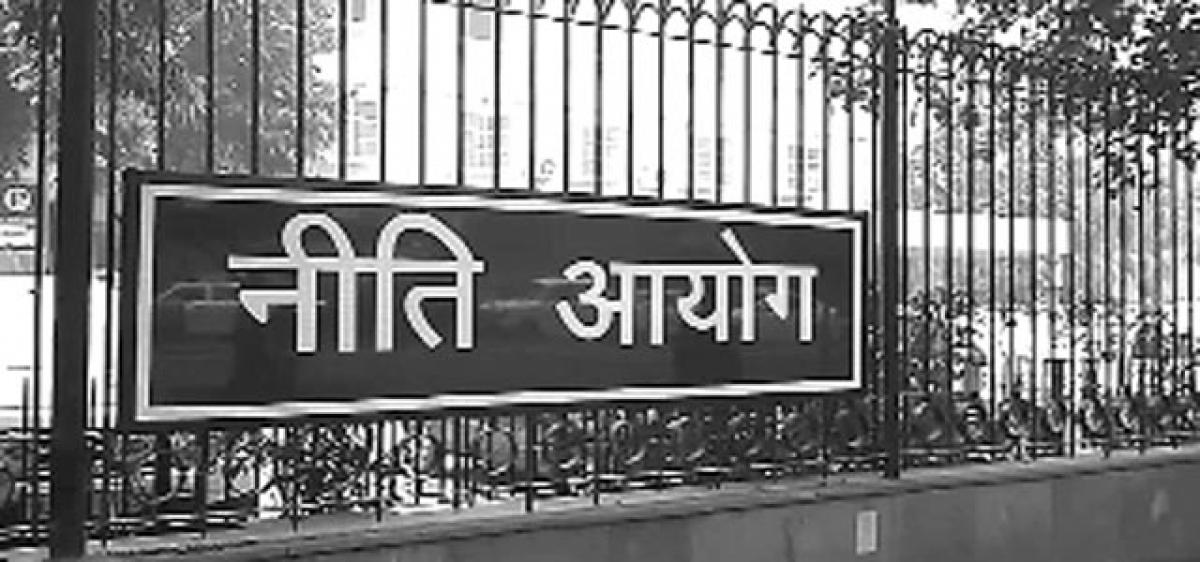Live
- Ticket sales commence for Indo-Bangla T20 match
- Now, Filipinos to relish rice from Telangana
- Revanth rescues tribal being exploited in Saudi Arabia
- Kantara’ song unveiled by Nikhil
- Owaisi demands arrest of UP priest for blasphemous remarks
- Nalgonda farmers support Musi development project
- Star producer Dil Raju unveils title poster of ‘Trikaala’
- Govt notifies HYDRA ordinance
- Should temples be free of govt control?
- Over 60% polling in Haryana assembly polls
Just In

It is known that NITI Aayog was established replacing the earlier Planning Commission with the objective of acting as a premier policy ‘Think Tank’ of the Government of India.
It is known that NITI Aayog was established replacing the earlier Planning Commission with the objective of acting as a premier policy ‘Think Tank’ of the Government of India. It is desired that the institution would provide directional and policy inputs to the Centre and States. The core of the Aayog’s work is divided into two hubs: ‘Team India Hub’ and the ‘Knowledge and Innovation Hub’.
While the former leads the engagement of States with the Centre; the latter is entrusted with the responsibility of building Aayog’s think tank capabilities. The Aayog is constituted with Prime Minister Modi as the Chairperson, Arvind Panagariya as the Vice-Chairperson and three fulltime members. While scrapping the Planning Commission which was established in 1950, it was declared that the government is intending to foster ‘Cooperative Federalism’ by bringing States to act together in national interest.
In addition, the Aayog has identified seventeen Sustainable Development Goals (SDGs) along with 169-related targets, which include: No Poverty; Zero Hunger; Good Health and well-being; Quality Education; Gender Equality; Clean Water and Sanitation; Affordable and Clean Energy; Decent Work and Economic Growth; Industry, Innovation and Infrastructure; Reduced Inequalities; Sustainable Cities and Communities; Responsible Consumption and Production; Climate Action; Life Below Water; Life on Land; Peace, Justice and Strong Institutions; and Partnerships for the Goals.
While the objectives of the Aayog are laudable, the question remains as to what is to happen to the Five Year Plan process. The Central, States and the Local Bodies (LBs) have got thoroughly involved in the concept and implementation of the old process. With the abolition of the Planning Commission, people are in doubt as to whether the Planning Commission was only done away with or the entire planning process. While accepting SDGs as targets to be achieved, we may suppose that the planning process is alive. Instead of having quinquennial periods, we may have a perspective plan of 2016-2030; which is termed consistent with the UN Charter.
The implementation machinery hitherto got accustomed to the setting of targets, mid-term reviews, revisions/modifications, etc. This apart, in the earlier planning process, there was an attempt to cover every conceivable economic activity impacting the growth and development of the economy and also life styles of the people. Now the entire focus appears centred on the so-called 17 SDGs. May be in future, certain other goals may find place. It is not so far clear as to how the targets on GDPs, GSDPs, HR Indices would be integrated.
Further, the new government could dispense with the Planning Commission; but not with the National Development Council; an organisation that started functioning from 6th August, 1952. The NDC with Prime Minister as its Chairman comprises all the Union Ministers, Chief Ministers and the Members of the Planning Commission. Even after the present Government assumed office, a meeting was held to seek cooperation from the States in the development of the country. There was also the news that this Council also would be scrapped and NITI Aayog Council would assume the powers of the NDC.
It is hard to imagine that the NITI Aayog Council will take over all the functions of the NDC, since NITI Aayog has not taken over all the functions of the Planning Commission. There appears a yawning void in respect of what the scrapped Planning Commission did and what the Aayog is doing; people of the country are not able to get convinced on the rationale of these measures. Should it be understood as simply destroying the legacy of the Nehruvian regime; or would it serve any other purpose. It is also hard to seek that there would be clarity in the remaining period of just two-and-a-half years. After all, institutions and systems evolve over a considerable period of time! Destruction is easy; but not their construction.
At it appears, the government is now at the threshold of making a decision as to what it has in store as far as the planning process is concerned.
In another four months (by March 2017), the Twelfth Five Year Plan is drawing to a close. People of the country, including economists are anxious to see whether there would be any Thirteenth Plan or a new document in its place; or no document. Though there has been indication in the Budget for 2016-17 that the distinction between Plan and Non-plan would be done away with from 2017-18; there was no clue as to whether the entire planning process would be dispensed with. (Writer is a Former Vice-Chancellor, Acharya Nagarjuna University, Guntur)
By Prof K Viyyanna Rao

© 2024 Hyderabad Media House Limited/The Hans India. All rights reserved. Powered by hocalwire.com







